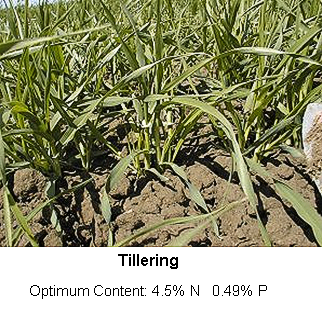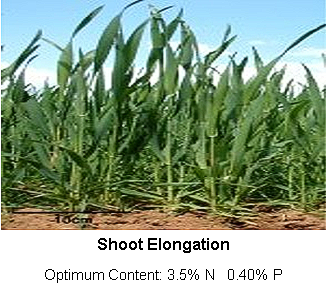Crop Monitoring Programs to help you plan your season.
Wheat is the premier small grain of American agriculture. The United States harvests 53 million acres annually which yield 13% of the world’s wheat supply. To maintain high yields, wheat requires a plentiful supply of nutrients. To get the crop off to a good start, a comprehensive soil test that measures only plant-available nutrients to determine initial fertilization requirements must be conducted well before planting. Thereafter, leaf testing at critical development stages is essential to determine nutrient deficiencies so that they may be corrected before they cause permanent reductions in crop yields and quality.
Potassium (K), Sulfur (S), Calcium (Ca), Magnesium (Mg), and trace elements including Iron (Fe), Zinc (Zn), Molybdenum (Mo), Manganese (Mn), Copper (Cu), Boron (B) and Chloride (Cl) in the needed amounts.
Additionally, Silicon (Si) has been shown in recent studies to be extremely beneficial to wheat (in addition to other plants). It strengthens cell walls, thereby decreasing lodging and providing some resistance to disease and insect pressures. Additionally, Silicon can reduce abiotic pressures brought on by drought or excessive soil Sodium (Na). Silicon can also help soubilize plant-unavailable soil nutrient compounds.
Nutrients Removed by Wheat
| 80 Bushel Yeild | N / Acre | P/ Acre | K / Acre |
|---|---|---|---|
| Grain | 96 lbs | 44 lbs | 27 lbs |
| Straw | 38 lbs | 10 lbs | 135 lbs |
| Total | 134 lbs | 54 lbs | 162 lbs |
* IMPORTANT NOTES ABOUT THIS TABLE *
♦ The numbers shown were compiled from several different sources and are approximate only. The table is presented for rough planning purposes. ♦ Actual demands for some of the nutrients shown can vary dramatically and be reduced, depending upon the timing of applications, soil and irrigation water chemistry, and growing conditions. ♦ To achieve best crop quality and yields, regular ASK THE PLANT® leaf testing at critical stages of physiological plant development during the growing season is crucial. ♦ To achieve yield goals, it is essential to accommodate the plants’ changing nutritional demands by providing adequate amounts of only those nutrients that are needed when they are needed.
SIGNS OF NUTRITIONAL PROBLEMS
If nutrient deficiencies occur during growth, some loss of yield (and quality) is almost inevitable. How does one know if a deficiency is developing?
The onset of visual symptoms can help diagnose nutrient deficiencies. Some symptoms, such as Nitrogen, appear as yellowing of older, lower leaves while upper younger leaves stay green for a while.
However, Sulfur deficiency can mimic Nitrogen deficiency, so is more difficult to determine. Other deficiencies (and toxicities due to excessive nutrients) may not display distinctive visual signs. This is particularly true for trace element deficiencies.
By the time nutritional problems appear to the eye, the crop has already lost its ability to deliver best performance.
While it’s important to learn the visual signs of nutrient deficiencies, it’s important to recall that by the time visual signs of deficiencies appear, much damage has been done already and the crop will not be able to deliver its potential. Nutrient-deficient plants are also more susceptible to insect damage and losses to disease, contributing to yield losses and making necessary expensive pest treatments.
These factors make plant tissue testing for trace elements particularly necessary. Periodic testing can reveal a coming deficiency before it can reduce growth and development of the crop, giving the grower time to act to maximize yields and quality.
Testing programs cost only about 1 to 2 bu/ac depending on the level of management and goals.
There are three ideal times to test:
1. At Tillering (Feekes 2.0 – sample entire plant: 30-50 plants) analyze entire plant for NPK plus minerals and micronutrients.
♦ Take 15 plants - wash off all dirt before wilting - air dry and place in paper (NO plastic) sacks for shipment to the lab.
♦ Take plants from a representative area of the field, one plant from every 5th row in a diagonal pattern across field, start at least 50’ inside fields, away from edges, do not mix problem areas. Sample problem areas separately.
♦ Never send samples in sealed plastic bags. Wash samples thoroughly to remove any soil, fertilizer or spray residues, remove excess water with a paper towel and allow samples to air-dry. Place in paper (NO plastic!) bags for shipment to the lab. The time between taking a plant sample and receiving results and recommendations needs to be as short as possible (48 hours) to allow the grower time to balance the plants’ nutrition before visual symptoms appear.
2. At Shoot Elongation (Feekes 4.0-5.0 – entire plant: 20-30 plants)
♦ Take 12 leaves from most recently mature leaf – (full dew lap (sheath) showing) - cut at dew-lap for entire leaf including base of mid rib - mature leaves will have most of the sheath showing.
♦ Take samples from the same area and pattern of field as before. At this point, the plant is entering maximum usage period of moisture and all nutrients.
♦ Apply foliarly or in water any deficient nutrient especially Zinc for 2. Nitrogen use efficiency and the proper plant growth. Hormones can stimulate root and grain growth.
Join Our Mailing List
Thank you for joining our mailing list. You will now begin to receive event announcements, newsletters and all of our latest updates.
Please try again later.
Email Us
For general inquiries and questions, contact us via email.
(956) 383-0739info@tpslab.com
Refund Policy
Billing Terms and Conditions
All Rights Reserved | TPSL







